So, with this update, I will see if I can make things right by getting you caught up on what has been happening since my last blog about the Tikopia Islands on Febuary 18th. Since then, the ship has made stops at the Islands of , Santa Ana, Guadalcanal, Lumalihe, and lastly the tiny island of Njari. All of these islands are part of the Solomans, and today, February 23rd, is our last day in the Solomons as we have just raised the anchor and are headed to Papua New Guinea.
Thursday February 19th Utupua Island:
We were given a warm and tumultuous greeting to the island of Utupua. I say warm because the local villagers were on the beach in large numbers to welcome us to their village, Nembao. It is the main village on the 26 square mile island, and the locals were clearly glad to see us. I also said that our welcome was “tumultuous” because as each zodiac approached the beach a large group of young males, dressed as warriors, came rushing from behind the bushes while brandishing wooden swords and yelling threateningly. Of course it was all in fun, and the minute the “performance” was over, the youngsters went off laughing and frolicking up the beach. At this point, we were at liberty to tour the village, which as we have seen previously, might have been primitive and the homes spartan, but it was as neat as possible. I did catch sight of photoelectric units mounted besides several huts, and I also saw a cell phone or two; the modern world is creeping slowly into even this remote village.
The time finally arrived for the welcoming ceremonies, and they were very elaborate and unlike anything we have seen previously. Setup in the center of the village was a circular compound which was fenced off by a bamboo fence. Extending from the center of the compound was a very long and elaborately adorned pole which was lying on the ground with one end located in the center of the compound and the other lying on the ground at some distance away. The end of the pole outside the compound was secured by very long vines which ran up into the trees. For the life of me I could not imagine what all this was about. With my bum knee, I was having trouble standing so long, and to my amazement one of the locals built a seat for me out of cinder blocks. I felt like a chief, and even offered to fulfill any wishes our crew might have – no one accepted my offer however. Soon the pace of things increased and young men started to climb up into the surrounding trees where they could grab the vines attached to the pole. Then in a flurry of activity which was coordinated by the chief, slowly, very slowly, the pole was raised upright in the center of the compound. For the life of me, I could not imagine the significance of the pole. It was elaborately adorned with what I would call, Christmas tree like ornaments hanging high above the ground on protrusions from the top. Soon I heard the singing and chanting of men and women alike who were dressed in leaves. They formed a line and danced into the compound where they circled the pole in a series of rhythmic and enchanting dances. Afterwards a group of young men dressed as traditional warriors, danced for us, and it was over.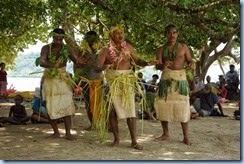 Later we learned that the elaborate dance we had witnessed had to do with a story related to a snake. The pole represented the snake and the long lines of the dancers as they moved in a snakelike fashion were likewise related to this story. When the greetings and gifts were exchanged, we took a zodiac ride along the fjord which ran deep into the island’s interior, however, when the heavy rains arrived, we headed to the ship, wet to the bone, but happy.
Later we learned that the elaborate dance we had witnessed had to do with a story related to a snake. The pole represented the snake and the long lines of the dancers as they moved in a snakelike fashion were likewise related to this story. When the greetings and gifts were exchanged, we took a zodiac ride along the fjord which ran deep into the island’s interior, however, when the heavy rains arrived, we headed to the ship, wet to the bone, but happy.
Friday February 20th Santa Ana Island:
Here we are in yet another island paradise complete with clear blue skies, white sandy beaches, and coral reefs seemingly everywhere you looked. Our ship anchored in the small bay in front of the main village of Ghupuna. Going ashore in a wet landing on a beautiful sandy beach, we were welcomed by locals and invited to tour the village at our leisure. Lisa and I headed in the general direction in which the welcome ceremonies would be conducted, but it was obvious that this was a rather large community and pretty well organized. Yes, the homes were built in the traditional manner made of local timber and leaf, and were built on stilts. What caught my eye immediately was the array of pipes which crisscrossed the village. I later learned that these pipes brought fresh water from a lake in the island’s center to each home.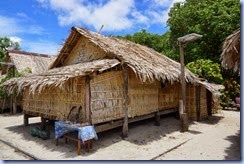 I also spotted solar panels outside almost every home which provided small amounts of electricity – at least enough to keep their cell phones charged.
I also spotted solar panels outside almost every home which provided small amounts of electricity – at least enough to keep their cell phones charged.
The festivities were to take place in what appeared to be a soccer field, and they had set up plastic chairs for us in order to watch the shows. Unlike earlier islands where the greeting ceremonies had the feeling of authenticity, it appeared that in this village they were presenting a show just for us. Most of the locals ignored the presentation. We had two performances. The first was women singing and dancing, but the second was much more elaborating, colorful, and rather unique. But neither took very long, and it was time to head back to the ship since tomorrow marked the end of this cruise segment.
Thursday February 21th Guadacanal:
This stop was entirely different than any of our prior visits. For one thing, the ship actually was able to pull into a real port and tie up alongside a pier. We had reached the city of Honiara which is the largest city on the island of Guadalcanal. This was also a “turn around day” which means that with the end of one cruise, many guests will be departing the ship, and almost immediately another group will be boarding. In fact, only six of us were staying on for the next cruise which I believe will have around 65 guests.
It is not uncommon for the ships to ignore the guests like us who are “in transit,” however; Silversea was thoughtful enough to arrange a tour of the area for us. The city is home to the famous “Henderson Field” from World War II fame. Originally built by the Japanese, it was taken by US forces and became the focal point for major battles in 1942. Lisa and I both had read extensively about the battles on Guadalcanal; in fact, I had an Uncle who served in the marines here. Our van drove us to the site of some of the bloodiest battles of the war which was a solemn moment for us. I looked across those hills, and could still see where the marines had dug foxholes for themselves. At the top of Edson’s bloody ridge, a white monument had been erected in recognition of the battle, but it was sad to see that the monument had not only been defaced, but the brass plaque on the front had been removed. Shortly after we arrived, children from all around came running carrying artifacts from the war which they wanted to sell us – old canteens full of bullet holes, marine helmets, bullets, etc.; it was all very disappointing.
As we drove around the “city,” I was disappointed to see how dirty and poor it seemed. We visited the National Museum. The good thing is that it was actually air conditioned, while the sad news is that it was nothing; not well maintained, not much of a collection, and just plain boring. Lastly, we climbed atop Skyline Ridge, which offered good views of the city below, but more importantly, it was there that we found the US War Memorial which is maintained by a little known commission of the US government.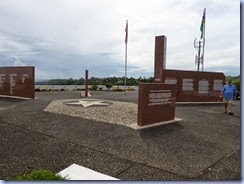 The Memorial was spotless and guarded at all times. Finally, we found a truly fitting memorial to what had happened on this island, and it made me proud that we were remembering those who sacrificed for our freedom. On our way back to the ship, we visited “Henderson Field. After about 4 hours we returned to our floating “home.” Well actually, we returned to a somewhat new home; for the first time we had to change rooms because we were not able to book the same room for the entire trip. Believe it or not we hardly had to lift a hand. Except for moving the contents of our safe before getting off the ship, our room steward took care of everything else. I’d say he had done this sort of thing before!
The Memorial was spotless and guarded at all times. Finally, we found a truly fitting memorial to what had happened on this island, and it made me proud that we were remembering those who sacrificed for our freedom. On our way back to the ship, we visited “Henderson Field. After about 4 hours we returned to our floating “home.” Well actually, we returned to a somewhat new home; for the first time we had to change rooms because we were not able to book the same room for the entire trip. Believe it or not we hardly had to lift a hand. Except for moving the contents of our safe before getting off the ship, our room steward took care of everything else. I’d say he had done this sort of thing before!
Thursday February 22th Lumalihe Island:
During our first cruise, there were several opportunities to snorkel, and both Lisa and I dutifully checked out our equipment. Only one little problem – well, make that two. I had not even been swimming for over a decade, let alone snorkel in deep water, and secondly, Lisa doesn’t know how to swim, although long ago she did some snorkeling with me. So on the few occasions when snorkeling was offered as part of the day, we both were tired by other activities, and trying snorkeling in the afternoon seemed just too much. In truth, I think we were both a little hesitant.
Now we come to Lumalihe Island which is located in Marovo Lagoon, one of the largest saltwater lagoons in the world. The American author James Michener described the lagoon as “one of the seven natural wonders of the world,” and the double barrier reef system of the lagoon is currently under consideration by UNESCO to be granted World Heritage Site status. If ever there was a location where snorkeling made sense, it was here.
In the morning, we made a quick visit to Lumalihe Island. Even though the island is not inhabited, word of our visit was common knowledge to the villages in the area, and people in large number came to the island in order to display and sell their carvings and crafts. In our honor, they also put on a brief performance. The first featured around 16 young boys led by an elder performing what I would call some basic cheerleading displays. Next was a group of women who sang a beautiful series of songs before the rains ran us and most of the crowd back to the ship.
I do have one cute story to share. One of the scientists, Malcom, is a biologist who delights in finding interesting things – plant or animal that we might not notice. And so as I came ashore I looked up and he had an animal that I did not immediately recognize, but was informed was a hermit crab.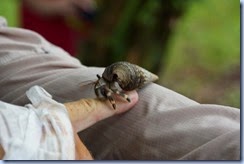 It was about the size of a small fist and was walking up his arm. He reached over and placed it on my arm whereupon it proceeded to walk up my arm towards my face. I asked Malcom if the little darling would bite, and he assured me that they were harmless, unless of course they felt threatened. Just before it reached my face, Malcom gently picked it up and turned it around so that it would go back down my arm, and this must have alarmed the little devil because he reached out with his big claw and gave me a right proper bite! So much for strange “cute” little creature--I think.
It was about the size of a small fist and was walking up his arm. He reached over and placed it on my arm whereupon it proceeded to walk up my arm towards my face. I asked Malcom if the little darling would bite, and he assured me that they were harmless, unless of course they felt threatened. Just before it reached my face, Malcom gently picked it up and turned it around so that it would go back down my arm, and this must have alarmed the little devil because he reached out with his big claw and gave me a right proper bite! So much for strange “cute” little creature--I think.
After a quick lunch back on the ship, I made the decision to try snorkeling. I was more than a little anxious, because even though I could swim, I was hosting both bum shoulders and an injured left leg. I first had to get down to the zodiac, which then took me to a zodiac pair. They were anchored over the snorkel site. I had to then transfer over to one of the pair, where I got left my reef runner shoes and got my face mask and flippers ready. Then I transferred to diving zodiac and after getting everything set, I nervously slid over the side into the warm water of the lagoon. Oh my – it was beautiful. In fact, it was more than beautiful, it was breathtaking. The sheer variety of fish and the vibrant colors were amazing. I told myself that I would stay in the water for only an hour, and when I looked at my watch the hour had passed. My biggest challenge was then to return to the zodiac. They had a ladder over the side which should have been fine, but between my injured left leg and my limited left arm, getting up turned into a real and embarrassing challenge. The crew was awesome and with their help, I finally made it, and I was really glad I had taken the plunge.
Thursday February 23th Njari Island, Solomons:
Finally I come to today at Njari Island. The ship has anchored off this Island for only one reason, and that is because it is a great dive and snorkel site. There will be no wet beach landing on the uninhabited island just an opportunity to enjoy a morning snorkeling. Two things are different about today vs. yesterday. First, and most importantly, Lisa decided to take the plunge and go snorkeling. The crew of the ship could not have done a better job of helping her, and immediately after getting in the water, the ship’s photographer stayed with her until she was sure that Lisa was fine by herself. The other thing that was different today is that I took an underwater camera with me. 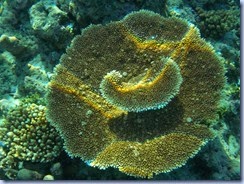 Several years ago I bought a cheap little Kodak underwater camera for a trip that ended up being canceled. When I saw it in the cabinet at home I decided to bring it and today I got a chance to use it. I had to learn how to use it on the fly and so much of what I did get was not great, but if I get the opportunity again, I think I’ll do much better.
Several years ago I bought a cheap little Kodak underwater camera for a trip that ended up being canceled. When I saw it in the cabinet at home I decided to bring it and today I got a chance to use it. I had to learn how to use it on the fly and so much of what I did get was not great, but if I get the opportunity again, I think I’ll do much better.
By 11am the ship lifted the anchor and we started on our trip northward which will see us leaving the Solomon Islands and docking tomorrow afternoon at the capital of Papua New Guinea, Rabaul.
I am sorry for this long update, and I really will try to stay more current as I move forward. I hear that weather in the Kansas City area is not good, and I would like to tell you that I feel guilty down here in the beautiful South Pacific – but in truth, I don’t.
Jim




No comments:
Post a Comment